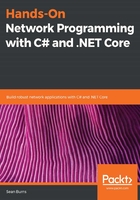
The application layer
I mentioned it before, but it bears repeating, application layer is where the vast majority of day-to-day network programming will take place. This is especially true within the .NET Core framework, since the libraries provided by that framework deliver a wide array of clean, easy-to-use abstractions for entities or responsibilities that must be programmed lower in the stack. So, first, let's see why we should be so concerned with the responsibilities of the application layer. We'll look at the kinds of responsibilities that are typically delegated to entities in the layer, and see how frequently those responsibilities overlap with the requirements faced by everyday .NET Core developers. Then, given the extensive range of use cases for entities in the application layer, we'll take a look at some of the common protocols used by entities at that tier of the stack. We'll seek to understand them on a fundamental level. We'll look at what classes and libraries we have available to us for each of those layers; however, after this chapter, my hope is that you'll have a deep enough understanding to be able to reconstruct those classes yourself.